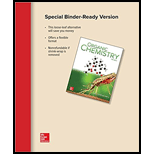
Concept explainers
(a)
Interpretation: The most stable arrangement of substituents on the six-membered ring by using chair form is to be drawn.
Concept introduction: Glucose is a monosaccharide. It is made by the plants during the process of photosynthesis. The molecular formula of glucose is
(b)
Interpretation: The chair form of glucose is to be converted into wedge-dash representation.
Concept introduction: Glucose is a monosaccharide. It is a simple sugar that is made by the plants during the process of photosynthesis. The molecular formula of glucose is
(c)
Interpretation: A constitutional isomer of glucose is to be drawn.
Concept introduction: Constitutional isomers have same molecular formula but the connectivity of the atoms is different.
(d)
Interpretation: The stereoisomer of glucose that has an axial OH group on one carbon is to be drawn.
Concept introduction: The two stereoisomers of glucose are
Want to see the full answer?
Check out a sample textbook solution
Chapter 4 Solutions
ORGANIC CHEMISTRY(LL)-W/ACCESS >CUSTOM<
- Label each ring in Figure 7.2 cis or trans.arrow_forwardGlucose is a simple sugar with five substituents bonded to a sixmembered ring. a.) Using a chair representation, draw the most stable arrangement of these substituents on the six-membered ring.b.) Convert this representation to one that uses a hexagon with wedges and dashed wedges.c.) Draw a constitutional isomer of glucose.d.) Draw a stereoisomer that has an axial OH group on one carbonarrow_forwardCircle each functional group in glucose (Problem 1.59) and sucrose (Problem 1.60). What compound class is characteristic of each of those functional groups?arrow_forward
- a. Pick one of the sugars above you did not find a mirror image for; draw an arrow pointing to that sugar. Next, below this question draw that sugar in the cyclized ring form as a β-pyranose ring b. Show the β(13) linkage between two of the same ring you drew.arrow_forwardDraw a cyclohexane chair with 2 substituents that requires a chair flip.arrow_forwardClassify attached compound as identical to A or its enantiomer.arrow_forward
- The photo below illustrates a/an __________ stereoisomer.arrow_forwardput the correct substituentarrow_forwarda) Draw the enantiomer of this molecule b) Draw a chiral stereoisomer of this molecule c) Draw the enantiomer of the molecule in part B d) Draw an achiral stereoisomer of this moleculearrow_forward
- (a) Using Newman projections, draw all staggered and eclipsed conformations that result from rotation around the bond highlighted in red in each molecule; (b) draw a graph of energy versus dihedral angle for rotation around this bond.arrow_forward(E) What suffix do all the names in Model 1 have in common with each other?arrow_forward
 Organic Chemistry: A Guided InquiryChemistryISBN:9780618974122Author:Andrei StraumanisPublisher:Cengage Learning
Organic Chemistry: A Guided InquiryChemistryISBN:9780618974122Author:Andrei StraumanisPublisher:Cengage Learning
